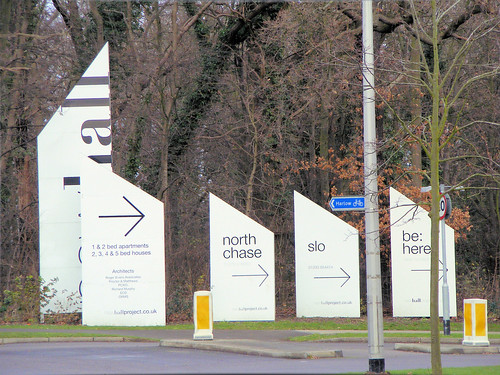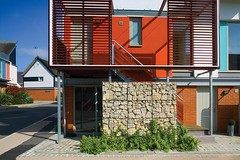Visiting Harlow
We recently went to Harlow for the first time, as a friend was exhibiting her wonderful painting/collage/constructions at the Gibberd Gallery there. Well known to architects as a New Town, it has recently been the focus of a new wave of development. It is also famous for its extraordinary collection of public sculpture - Moore, Frink, Rodin's Eve, Hepworth, Chadwick - and this policy continues today, with lesser or greater success.
Only architects, however, go to Harlow to look at the buildings, or the art. Everyone else is too busy shopping. Down the main drag of the 'old' New Town centre - a generous pedestrian boulevard in the usual faded brick and concrete; into the new shopping 'streets' of typical 90s/00s yellow brick and glass; the flow of people consuming was unstoppable, leading us down the civic centre where the gallery is housed. Whereupon the people disappear from our route, too busy making their way to the car park down by the river.
Civic Centre in 2010: a sort of compromised 00s attempt at the Festival Hall with brise soleils, where the prime frontages have been sacrificed to Nandos and Pizza Hut (Eve turns away in disgust) and a sign in the main entrance saying that in fact, that entrance is out of service so you must go round the corner.


Walk past the glazed wall, behind which sits a wonderful Henry Moore that wishes it was still out in the open air in front of the old Town Hall.

Walk down the side of the building to the back door. Inside, somewhat disoriented, leaflet racks, no clear reception desk, no signage to the gallery. Eventually, upstairs (past the Moore again) to an equally undistinguished gallery space, stuffed with wonderful art that no-one knows is there.

The founding father of Harlow, Frederick Gibberd, was clearly an uncompromising Modern Briton, and believed in the improving power of art: hence the sculpture commissions and this collection of the Modern British canon - Piper, Sutherland, Moore drawings, and so forth. Yet here they sit - as do our friend's works - badly lit, barely looked at, upstairs in a dingy council block. The water gardens outside - dotted with wonderful animalistic sculptures by Frink and William Mitchell - are beautiful and enjoyed by a steady trickle of escapees from the retail crush. In the busy throng they may barely notice the other sculptures, but they do - for all the unfashionable connotations of this kind of statement - elevate; transcend; dignify. But putting a collection (and indeed, an exhibition programme which includes the Hayward touring shows) under a suspended ceiling in a gallery you would never know even exists: what a missed opportunity.




Only architects, however, go to Harlow to look at the buildings, or the art. Everyone else is too busy shopping. Down the main drag of the 'old' New Town centre - a generous pedestrian boulevard in the usual faded brick and concrete; into the new shopping 'streets' of typical 90s/00s yellow brick and glass; the flow of people consuming was unstoppable, leading us down the civic centre where the gallery is housed. Whereupon the people disappear from our route, too busy making their way to the car park down by the river.
Civic Centre in 2010: a sort of compromised 00s attempt at the Festival Hall with brise soleils, where the prime frontages have been sacrificed to Nandos and Pizza Hut (Eve turns away in disgust) and a sign in the main entrance saying that in fact, that entrance is out of service so you must go round the corner.


Walk past the glazed wall, behind which sits a wonderful Henry Moore that wishes it was still out in the open air in front of the old Town Hall.

Walk down the side of the building to the back door. Inside, somewhat disoriented, leaflet racks, no clear reception desk, no signage to the gallery. Eventually, upstairs (past the Moore again) to an equally undistinguished gallery space, stuffed with wonderful art that no-one knows is there.

The founding father of Harlow, Frederick Gibberd, was clearly an uncompromising Modern Briton, and believed in the improving power of art: hence the sculpture commissions and this collection of the Modern British canon - Piper, Sutherland, Moore drawings, and so forth. Yet here they sit - as do our friend's works - badly lit, barely looked at, upstairs in a dingy council block. The water gardens outside - dotted with wonderful animalistic sculptures by Frink and William Mitchell - are beautiful and enjoyed by a steady trickle of escapees from the retail crush. In the busy throng they may barely notice the other sculptures, but they do - for all the unfashionable connotations of this kind of statement - elevate; transcend; dignify. But putting a collection (and indeed, an exhibition programme which includes the Hayward touring shows) under a suspended ceiling in a gallery you would never know even exists: what a missed opportunity.
Leaving the centre of town, we go in search of some of the new housing estates, particularly the award-winning New Hall. Driving somewhat aimlessly for a while, we eventually find it.

Hidden from the road by some trees, what reveals itself as one drives into the development is an utterly surreal landscape. Houses: yes, and flats too (though who wants to live in a flat in the countryside?)- densely clustered, in odd pockets of vastly different appearance and layout; streets: well, a few that are straight, but most are curving cul-de-sacs that end abruptly in a fence with fields beyond. Community: a piece of landscaping by Charles Jencks that, for all its predictability, is still the best thing about the place; a mum and a kid on a tricycle; not another sign of life. The much-lauded houses by Proctor Matthews are like 1950s semis that have had a materials samples store thrown at them, to see what sticks: gabion, wood, render, metal, brick, twenty different colours, glass, brise soleils, 'screens'.


Others are neo-trad pitched roof jobs. Some (by Alison Brooks) are lovely.

But a "model of the communities we have to build"? This development has won every gong going: RIBA awards, RTPI awards, Housing Design Award, CABE case study, Building for Life exemplar, you name it. But it is a zoo of housing design, a mashup of the Ideal Home Show miles from anywhere, accessible only by car. New Hall would, perhaps, be fun and successful near the town centre or in a suburban London borough, but here, in the middle of beautiful rolling fields, it looks as alien in scale and form as can be imagined. Even imagining living in this Truman Show of a place makes me reach for the Prozac.
Why do we build on green belt, and yet insist on faking some kind of 'urbanism'? We try to create 'urban villages' in our cities and somehow, amputated suburbs where villages should be. New Hall is totally dislocated from Harlow itself, hidden off a main road as a prison might be. The masterplanners talk about making a place for walking and cycling. As if there is anywhere to walk or cycle to, except round and round in circles down home zone streets, when the rest of the world is the wrong side of an A road.
I am perhaps harsh, seeing as (surprise!) the uncompleted Phase 2 of this 2000 home development is meant to include the 'district centre' with primary and nursery schools, employment and 'recreation' "to serve the everyday needs of this sustainable community". But really this is just Poundbury in a different colour palette. We like suburbs; we like villages; we like pretty houses with human scale and walkable streets and trees; but we sure don't think it has to be like this.
0 Comments:
Post a Comment
Subscribe to Post Comments [Atom]
<< Home